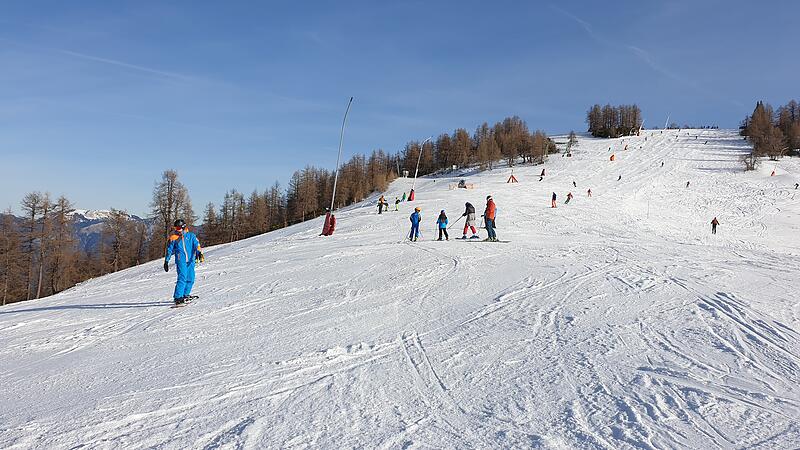Otherwise, the company is currently not profitable, it is said. The Hinterstoder-Wurzeralm mountain railways are assured that they will reopen next winter. A look at the Upper Austrian (winter) landscape shows that the ski areas do not have it easy in the area of tension between climate change and pandemic.
As a reason for the early end of the season on the Wurzeralm, Helmut Holzinger, CEO of the Hinterstoder-Wurzeralm (HiWu) Bergbahnen, states that the schools only received the green light for the sports weeks very late. In addition, day tourists were required to undergo a PCR test.
Ski courses relocated to Hinterstoder
Overall, the number of guests – 500,000 in normal years – has fallen by around 30 percent. In the two years of the pandemic, sales were also reduced by around five million euros. The state now supports shuttle services that bring students from the quarters in Spital to the Höss in Hinterstoder at no additional cost for the parents. This is the only way the season can be presented economically, says Holzinger. According to Economic Councilor Markus Achleitner (ÖVP), the state, which holds shares in HiWu-Bergbahnen, has the early closure of cable car operations “on condition that, depending on the course of the pandemic, a ‘normal’ season with longer operating times will take place next winter”. agreed.
More tourers, fewer full-payers
At the top of the Wurzeralm, there was uncertainty as to how the lift operation would continue due to the low occupancy rate. The trend that there are more and more tourers and fewer and fewer full-paying skiers is observed with concern. Holzinger counters rumors of closure. You will unlock again next season “fix”. The state is currently running an EIA assessment procedure for the planned renewal of the Frauenkar Bahn, which is viewed skeptically by nature conservationists. In the sister region of Hinterstoder, very concrete plans are being rolled out for a new ten-person gondola with 3,200 people per hour: Although not all the permits for the 20 million euro project have been received yet, Holzinger expects the groundbreaking ceremony to take place in June.
Expansion on ice
However, expansion plans in the Pyhrn-Priel area have been repeatedly rejected for years: the initial plan to connect the Hinterstoder and Wurzeralm ski areas – first via a ski area, then with a 4.5-kilometer tunnel – via the Warscheneck nature reserve did not go through. In the meantime, the plan for a gondola lift from Vorderstoder to Wurzeralm has apparently been abandoned. Most recently, they wanted to connect the Höss with the former Hackl lifts in Vorderstoder via three cable cars and create 10.7 kilometers of ski slopes at an altitude of less than 1,100 meters including snowmaking. A citizens’ initiative is opposed to this.
Even if people in the ski areas are always optimistic and politicians stick to school ski courses, critics often argue that climate change will eventually make skiing impossible, especially in the alpine fringes such as Upper Austria. The forecasts are actually not too rosy: A study by Boku climate researcher Herbert Formayer and his ZAMG colleague Marc Olefs on the development of the natural snow cover in the Pyhrn-Priel region predicts less snow in the future – especially not such masses that outdoor Activities off the slopes allow – and more often rain, 30 centimeters of snow in valleys only in exceptional winters.
In the FuSE-AT project, researchers led by ZAMG have also calculated that even if the two-degree target of the Paris Climate Agreement is reached, only eight days with snow cover can be expected at altitudes below 400 meters in 2100. That would be a halving of what it was previously. In 1,000 meters 60 (minus 25 percent) and in regions between 1,500 and 2,500 meters 190 days of snow cover (minus ten percent) are to be expected. Atmospheric conditions for artificial snowmaking would also deteriorate significantly – by 15 percent at medium altitudes and by ten percent at higher altitudes.
Children’s ski lift planned in the Innviertel
In view of rising prices and temperatures, Upper Austrian families are faced with the question of where in the region they can still go skiing for a day. Because also on Kasberg local ski clubs are concerned about the continued existence. Achleitner emphasizes that due to the “great regional economic importance”, the state of Upper Austria decided in 2016 to cover the operation of the cable car and ski lift systems on the Kasberg until the 2025/26 ski season. In order to secure the location economically beyond that, he commissioned an overall tourism concept. This year the season at Kasberg is expected to run until March 27th.
But there are still efforts to build mini ski areas: In Engelhartszell In the Innviertel, for example, the contractor Roman Moser wants to build a completely new ski lift – on a children’s ski hill with a magic carpet and drag lift, he wants to enable children from the region to learn to ski at home. “This is not an economic yield project,” explains the contractor. “We won’t drive three months, but one and a half to two,” he is realistic. The operation is planned to be CO2-neutral, with PV systems and water from surface water.
No skeptical
Environment Councilor Stefan Kaineder (Greens) is highly skeptical about the project: In order for skiing to be possible for a few weeks on the southern slope at 700 meters above sea level, the clearing of a valuable forest and enormous amounts of water and energy are necessary. In this context, he likes to refer to Kirchschlagwhere he grew up: 25 years ago there were eleven ski lifts in the traditional family ski area just outside of Linz, now there are only three – and these are dependent on snowmaking. As far as the project in Engelhartszell is concerned, “the supervisory authority of the state of Upper Austria judged that the planned dedication should clearly be rejected as a whole”.
Of course, two hectares of forest would have to be sacrificed, but Moser sees no damage to nature: “Engelhartszell has 60 percent forest and every year 2.7 hectares are reforested, more than is needed for my project.” This argument also counts for Mayor Roland Pichler (ÖVP), who is fundamentally positive about the project. In the next two municipal council meetings, a decision must be made as to whether a rezoning procedure should be initiated.
Source: Nachrichten




